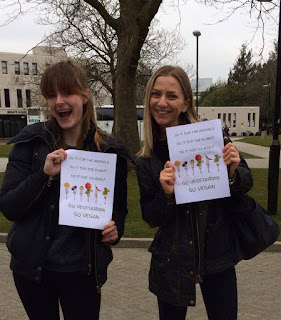My project involved students writing down a grateful thought everyday for a week, with my target being to reduce their stress and thus allow for better exam performance. Studies show that excessive stress, which has a negative correlation with student performance, can be ameliorated via positive thinking. Thus, fliers with 7 daily slots for writing grateful thoughts and rating stress level were not only distributed but also placed on tables in the Student Union atrium, the library, Tocil hall and PAIS common room to attract students.
Thus, fliers with 7 daily slots for writing grateful thoughts and rating stress level were not only distributed but also placed on tables in the Student Union atrium, the library, Tocil hall and PAIS common room to attract students. The rationale for putting the fliers around campus was the availability heuristic; the more people saw the flier, the more likely they were to pick it up (Pratkanis, Pratkanis & Aronson, 2001).
The rationale for putting the fliers around campus was the availability heuristic; the more people saw the flier, the more likely they were to pick it up (Pratkanis, Pratkanis & Aronson, 2001). The goal was for individuals to deposit anonymous feedback on their stress and positivity level at the end of the week in a drop box so I could measure the efficacy of the intervention. Hence, the flier had a statement saying “by returning this section, you agree to the use of your anonymous feedback for research purposes”, to account for informed consent. However, I did not get substantial responses to allow for proper deduction. Nonetheless, I believe this project aided positivity and stress relief in students. Future interventions can use a more comprehensive method of participant recruitment and follow-up to gather necessary data for true empirical support.ReferencesEmmons, R. A., & McCullough, M. E. (2003). Counting blessings versus burdens: an experimental investigation of gratitude and subjective well-being in daily life. Journal of personality and social psychology, 84(2), 377. Pratkanis, A. R., Pratkanis, A., & Aronson, E. (2001). Age of propaganda: The everyday use and abuse of persuasion. Macmillan.Vanessa Ajagu
The goal was for individuals to deposit anonymous feedback on their stress and positivity level at the end of the week in a drop box so I could measure the efficacy of the intervention. Hence, the flier had a statement saying “by returning this section, you agree to the use of your anonymous feedback for research purposes”, to account for informed consent. However, I did not get substantial responses to allow for proper deduction. Nonetheless, I believe this project aided positivity and stress relief in students. Future interventions can use a more comprehensive method of participant recruitment and follow-up to gather necessary data for true empirical support.ReferencesEmmons, R. A., & McCullough, M. E. (2003). Counting blessings versus burdens: an experimental investigation of gratitude and subjective well-being in daily life. Journal of personality and social psychology, 84(2), 377. Pratkanis, A. R., Pratkanis, A., & Aronson, E. (2001). Age of propaganda: The everyday use and abuse of persuasion. Macmillan.Vanessa Ajagu
‘Go Vegetarian, Go Vegan’ Campaign
For our project, we wanted to see if our posters could influence whether people would favour vegetarian options in Xananas. We designed a poster which promoted the choice of vegetarianism and veganism. We wanted to see if the mere exposure of the posters, could influence the choice of meal they have at xananas.  The mere exposure effect (also known as the familiarity principle) suggests that people favour stimuli they have been repeatedly exposed to compared to unfamiliar stimuli (Zajonc, 1968).
The mere exposure effect (also known as the familiarity principle) suggests that people favour stimuli they have been repeatedly exposed to compared to unfamiliar stimuli (Zajonc, 1968).  By sticking up our posters around campus, we hope that the mere exposure and familiarity of ‘the vegetarian option’ will aid people to pick vegetarian menu items in Xananas. To see if our posters had any effect, we compared the average of term 2 meal sales to one day where we exposed our posters. We wanted to see if the sales of vegetarian meals increased.
By sticking up our posters around campus, we hope that the mere exposure and familiarity of ‘the vegetarian option’ will aid people to pick vegetarian menu items in Xananas. To see if our posters had any effect, we compared the average of term 2 meal sales to one day where we exposed our posters. We wanted to see if the sales of vegetarian meals increased.  Our results can be seen in the table. For breakfast and main meals there is an increase in vegetarian sales. However, starters and sandwiches did not increase with the exposure of our posters.
Our results can be seen in the table. For breakfast and main meals there is an increase in vegetarian sales. However, starters and sandwiches did not increase with the exposure of our posters. To some extent, we can suggest that the exposure effect has been seen and has influenced peoples’ choices in their meals. Jessi Silvester, Laura Schmidt, Hannah Stewart & Robyn CufleyReferences Zajonc, R. B. (1968). Attitudinal effects of mere exposure. Journal of personality and social psychology, 9, 1.
To some extent, we can suggest that the exposure effect has been seen and has influenced peoples’ choices in their meals. Jessi Silvester, Laura Schmidt, Hannah Stewart & Robyn CufleyReferences Zajonc, R. B. (1968). Attitudinal effects of mere exposure. Journal of personality and social psychology, 9, 1.
Respect for the Retired
The aim of the project was to reinstate the social norm of offering up one’s seat on a bus to an elderly passenger. From observation, one can see that this once social norm is disappearing. Indeed, as a control condition I observed passengers at a bus stop in Coventry. During this control condition I recorded that a mere 12% of young people offered their seat to an elderly passenger. This left the older person standing for the length of the journey, or having to make their way to the top floor of the bus. In order to encourage people to engage in the pro-social behaviour of offering their seat to an elderly passenger, two posters were created. Poster one (below) was placed at a bus stop in Binley, Coventry. The introduction of this poster saw our target behaviour (of young people offering up their bus seat to an elderly passenger) increase by 42%, compared to the control condition.. A week after the introduction of the first poster, I placed poster two (below) at the same bus stop. Poster two, on the other hand, only increased the target behaviour by 31%, compared to the control condition.
The two images below, show the posters placed at the bus stop.
Shannon FlynnAnjali KapoorDiana Lee